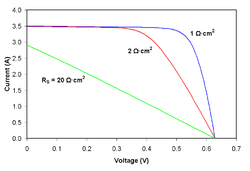
Effect of series resistance on the current-voltage characteristics of a solar cell
As series resistance increases, the voltage drop between the junction voltage and the terminal voltage becomes greater for the same flow of current. The result is that the current-controlled portion of the I-V curve begins to sag toward the origin, producing a significant decrease in the terminal voltage V and a slight reduction in ISC, the short-circuit current. Very high values of RS will also
produce a significant reduction in ISC; in these regimes, series resistance dominates and the behavior of the solar cell resembles that of a resistor. These effects are shown for crystalline silicon solar cells in the I-V curves displayed in the figure to the right.
Losses caused by series resistance are in a first approximation given by Ploss=VRsI=I2RS and increase quadratically with (photo-)current. Series resistance losses are therefore most important at high illumination intensities.
No comments:
Post a Comment